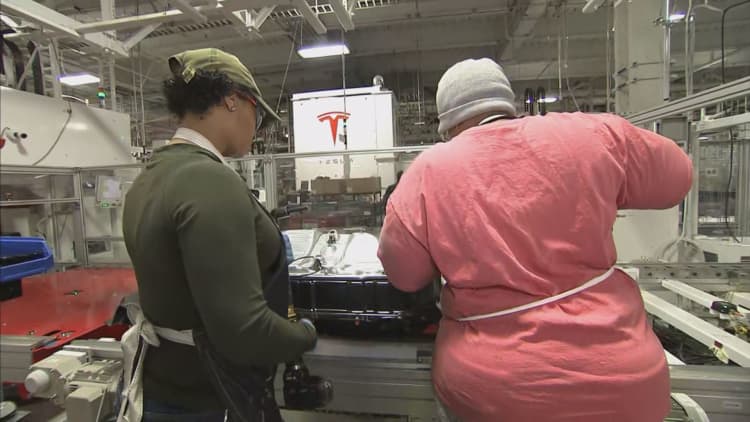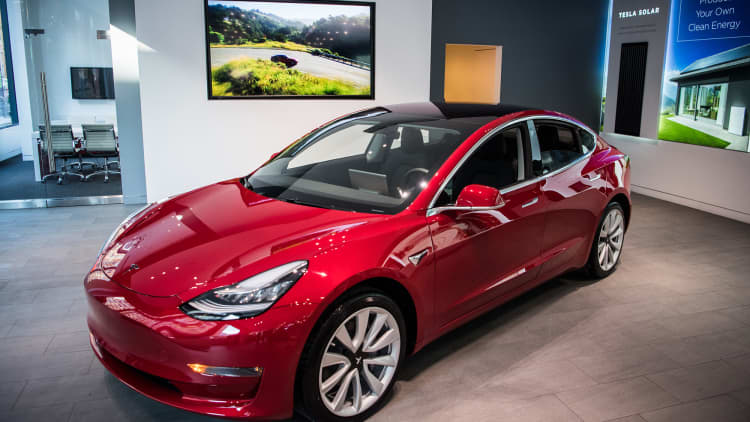Tesla executives still have not decided where to manufacture the company's forthcoming crossover SUV, the Model Y, according to six current and former employees. This despite the fact the company is planning to formally unveil the vehicle for the first time on March 14 at the company's design center in Hawthorne, California.
Two other people who work for Tesla vendors said the automaker did not contact them about working together on Model Y production until after CEO Elon Musk teased the unveiling in a tweet on March 3. That's one indication Tesla has barely begun planning for Model Y manufacturing, they said.
Musk has already said the Model Y should cost about 10 percent more than the Model 3, which starts at $35,000.
Along with a pickup truck that Tesla plans to unveil later this year, the Model Y could ensure that Tesla's lineup stays competitive versus offerings from other electric truck and SUV makers. Those rivals include Rivian, a newcomer funded by Amazon, and established automakers like BMW and Hyundai, who are honing in on Tesla's territory with electric cars.
Employees say Tesla executives, including its president of automotive, Jerome Guillen, are wavering between two options for Model Y production. They are trying to decide whether Tesla should allocate space in the Gigafactory, the company's massive battery plant outside of Reno, Nevada, or combine the Model S and Model X body lines at its car plant in Fremont, California, to make room to build the crossover SUVs.
One employee said if executives have made a decision, they haven't given a green light to employees who will be involved in setting up the Model Y lines and eventually building the vehicles.
A Tesla spokesperson pointed to a February letter to shareholders, but declined to offer an update on Model Y planning. The letter said, "This year we will start tooling for Model Y to achieve volume production by the end of 2020, most likely at Gigafactory 1."

Why the Model Y
According to forecasts from LMC Automotive, SUVs are expected to comprise 50 percent of all car sales in the U.S. by 2020, up from about one-third in 2013. The Model Y could help Tesla tap into that wave of demand and gather up customer's reservation payments meanwhile before production begins.
In its fourth-quarter update, Tesla said that the Model Y should share about 75 percent of its components with the Model 3. Car companies typically share parts between models to save on development and production costs. Tesla has never made cars with that many parts in common before, but it intended to. Its Model S and Model X wound up sharing less than one-third of their parts, Musk told analysts on the fourth-quarter earnings call Jan. 30.
Current and former employees say that setting up a Model Y line at the Gigafactory may require buy-in from Panasonic, Tesla's battery cell supplier and a major partner in the Gigafactory.
A Tesla proponent at Panasonic, Yoshio Ito, the Japanese company's executive vice president of automotive, recently resigned, the company disclosed at the end of February. When Tesla and Panasonic established their Gigafactory partnership in 2014, their agreement said the two companies would have to mutually agree on how to manage "the land, building and utilities" at the facility.
Panasonic did not reply to requests for comment.
Employees noted the Gigafactory is constantly under construction, and not currently set up to handle things like body stamping, glass and seat installation, painting of cars and end-of-line quality control for assembled vehicles. Parts of the Gigafactory are cramped already, they added, so it's hard for them to imagine how Tesla can make room for increased battery production, material flow and workers needed to make the Model Y there in high volumes.
Deep cuts
At the same time, Tesla is in the midst of extreme cost-cutting measures in its quest to become profitable, and to make its electric vehicles mainstream.
Last week, the company announced it would move all vehicle sales online and close most of its retail stores, letting go of thousands of employees in the process. The ongoing workforce reduction follows a 9 percent layoff Tesla implemented in January 2019, and an earlier 9 percent layoff in June 2018.
Some Tesla stores will convert into galleries where customers can get information about its cars and maybe buy Tesla-branded merchandise the company said in a blog post Feb. 28.
One sales employee said Tesla has left workers in the dark about whether or not their stores are closing, and whether or not they will have a job when the transition to online sales is finished.
On Tesla's website, the company listed 129 stores and galleries as of March 1. On March 6, the website listed 106 stores and galleries. Current and former Tesla employees said head count fell about 8 percent within the last week, basing their estimates on internal data. A Tesla spokesperson disputed that 8 percent figure on Thursday, but declined to provide more information.
A Tesla spokesperson said that as of the week of March 4, the company employed more than 40,000 people. In its 2018 annual report, Tesla said it had 48,817 employees. Subtracting an estimated 9 percent for January's layoffs brings that total down to 44,423 and subtracting another 8 percent — following Tesla's move to close most stores — would put Tesla's head count around 40,869 today.

Machine that builds the machine
Meanwhile, Tesla management has asked employees to limit their travel and work remotely whenever possible, as one of many ways to save costs.
In a recent e-mail that Musk sent to Tesla employees the CEO warned of more belt-tightening to come. He wrote:
"In the coming weeks, we will be evaluating all areas of our sales and marketing organization to understand where there are operational efficiencies, and how best to support the transition to online sales, while also continuing to deliver a truly awesome and educational Tesla buying experience."
In Fremont, small items like rivets and fasteners have been in limited supply recently, when there used to be a surplus on-site, one employee said.
At the Gigafactory, management has sent hourly workers home mid-shift or asked them to take personal time off or volunteer for unpaid time off in recent weeks, leaving some with less income than they planned to earn. These people said that some Gigafactory shifts were canceled due to snow-related closures on Donner Pass, a highway Tesla relies on for consistent flow of supplies to and from the Gigafactory.
Workers at the Gigafactory also said that while the company's semi-automated battery production lines have improved by leaps and bounds in the past year, Tesla is still not consistently making 7,000 vehicle batteries a week there. Workers said they are striving to hit an 8,000 per week goal, which should allow Tesla to make 416,000 cars in a year.
Tesla gave guidance in its fourth-quarter earnings update that it was aiming to deliver 360,000 to 400,000 vehicles in 2019, about 45 percent to 65 percent more than its deliveries last year. More recently, Musk reiterated in a series of controversial tweets that Tesla should hit an "annualized production rate" of around 10,000 cars per week by the end of 2019, and still expected to deliver about 400,000 cars this year.
In 2016, Musk said: "What really matters is the machine that builds the machine — the factory. And that is at least two orders of magnitude harder than the vehicle itself."
That level of operational excellence remains a work-in-progress at Tesla.
— CNBC's Salvador Rodriguez contributed to this report.



